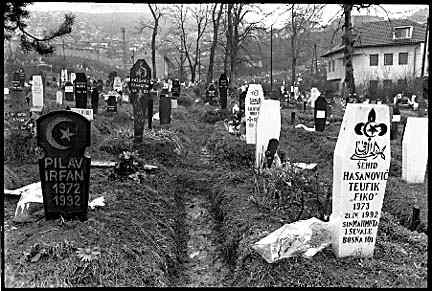




 |
 |
 |
 |
 |
|
| Contents Forward Backwards |
|
In 10, or 20, or 30 years when Sarajevo is rebuilt, a visitor may not observe any of the direct effects of the war, except for one noticeable exception: the cemeteries. Not only are there new grave markers everywhere, and in the most unlikely places, but what stands out is the similarity of the date of death--1992. It was during the first year of the war, when Sarajevans were caught most unprepared and least able to defend themselves, that most of the 12,000 deaths from sniper fire and mortar attacks occurred. One gravestone in particular stood out to me: a man born in 1892 who died in 1992. Many of the markers, though, are for young men, boys, 18, 19, 20 years old, who died defending their city. The largest cemetery is at the former Olympic stadium, adjacent to the Kosevo Hospital. This one is near Vratnik, the oldest part of town, and extends up a steep hill to an old Austro-Hungarian fort. The earliest deaths are up front, and as the markers ascend the hill, the dates are more recent, as late as December 1995. It was drizzling the day we were there and one family was placing plastic flowers near three grave markers and praying. |
 |